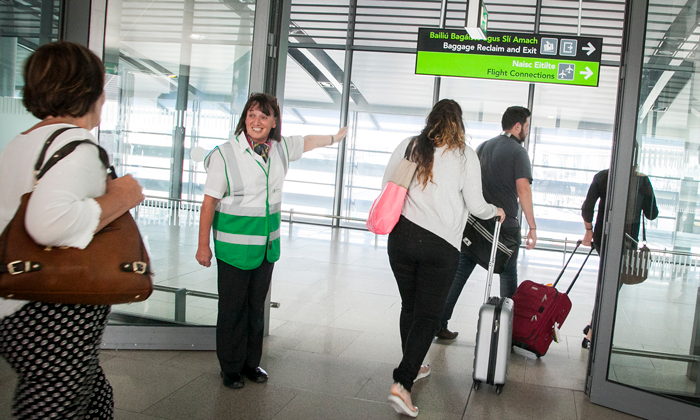Dublin Airport: Going beyond to deliver a seamless travel experience
- Like
- Digg
- Del
- Tumblr
- VKontakte
- Buffer
- Love This
- Odnoklassniki
- Meneame
- Blogger
- Amazon
- Yahoo Mail
- Gmail
- AOL
- Newsvine
- HackerNews
- Evernote
- MySpace
- Mail.ru
- Viadeo
- Line
- Comments
- Yummly
- SMS
- Viber
- Telegram
- Subscribe
- Skype
- Facebook Messenger
- Kakao
- LiveJournal
- Yammer
- Edgar
- Fintel
- Mix
- Instapaper
- Copy Link
Posted: 5 December 2017 | John Seely | No comments yet
Dublin Airport is seeing a continued positive trend in passenger numbers. John Seely, the airport’s Technology Projects Manager, explains here that creating a seamless and enjoyable travel experience is at the heart of everything the airport concentrates on for its customers.


IN 2016, Dublin Airport was rated number one ahead of all other European airports of a similar size in the airports survey quality results announced by Airports Council International (ACI).
Our first-place rating put us ahead of 14 peer airports in the Best Airport by Size and Region in Europe in the 15-25 million passengers per year category.
This was a very significant achievement for us, as a few short years ago Dublin Airport was placed at the bottom in its peer group of airports surveyed by ACI. Following that low rating we were determined to improve our customers’ experience and we have worked hard to maintain a top five position for five years, ultimately reaching the number one spot.
To achieve this improvement for our customers we seek the views of up to 30,000 passengers annually through detailed surveys. The results of these surveys are forensically analysed and many improvements are made to facilities and services based on our customers’ feedback.
Maintaining a seamless travel experience is a challenge when passenger volumes are growing significantly as they are at Dublin Airport. To put this in perspective, following a deep recession where passenger numbers fell by five million between 2009 and 2010, Dublin Airport has since enjoyed six years of consecutive growth with passenger numbers increasing by 49 per cent during that time. A new record was set in 2016 when Dublin Airport welcomed 27. 9 million passengers.
This trend is continuing as more than 22.7 million passengers have travelled through Dublin Airport in the first nine months of 2017, a six per cent increase on the same period in 2016; and so far we have welcomed an extra 1.3 million passengers between January and September 2017.
Maintaining a quality travel experience for all our passengers continues to be a key focus for us. To achieve that we have introduced a number of specific initiatives to help passengers have a smooth journey through the airport.
Important Flyer
We understand that many of our customers with autism can find travelling through the airport a very difficult and daunting experience. To assist these passengers we organise familiarisation tours, provide visual guides online, and also operate the Important Flyer initiative for passengers with autism. A special wristband and lanyard are available for passengers with autism travelling through Dublin Airport. This way all airport staff can easily identify these customers and ensure they have a smooth journey through the airport. The lanyard can be shown in key areas so that passengers with autism can be fast-tracked, thereby avoiding passenger queuing areas.
Families have been very complimentary of the Important Flyer and positive with feedback in relation to the assistance they have received at Dublin Airport, and are very grateful for the initiatives and the programmes we have in place.
Our Important Flyer initiative made such a difference for one particular family they sent the following feedback: “My son is high functioning so his autism is not always apparent to people but he gets overwhelmed in busy places that travelling can be a disaster. We got through Dublin Airport and back again from London with no issues, all thanks to the pass and my son never got upset once so thanks again.”
Flight Connection Hosts
The number of passengers connecting to another flight at Dublin Airport has grown by double digits in the past five years.
Every day, approximately 5,000 passengers take a connecting flight to another destination. To make the connection easier for them, we have introduced Flight Connection Hosts who meet the passengers on arrival at Dublin Airport and direct them to their boarding gate. The Connection Hosts are equipped with iPads containing a dashboard with real-time data showing flight information, the arriving gate and how many transfer passengers there will be on the flight.
Tight connection times will be highlighted in red, making it easy for the Flight Connection Hosts to greet passengers and escort them quickly through security, and to the U.S. Preclearance facility if required and then to their gate.
Flight Connection Hosts are the face of Dublin Airport for passengers transferring to another flight. They meet and greet passengers at the gate when they disembark, and are there to answer questions and provide information about gate numbers as well as services and facilities at the airport. The Connection Host can also help passengers who have a longer layover by recommending sights to visit close to the airport, such as the nearby picturesque villages of Howth or Malahide located in North Dublin just a few kilometres away.
Check-in
Real-time data is used to improve the passenger experience and drive efficiency at the check-in area in Terminal 2.
There is a high demand from our airline customers for check-in desks daily between 06:00 and 12:00. During this time, five airlines use a total of 28 desks to process over 2,800 passengers on 12 flights.
As many of these flights are flying to long-haul destinations, some 80-90 per cent of passengers will have luggage to check-in. Some of the airlines are required to conduct passenger profiling and ask more in-depth questions for safety purposes which can further lengthen the check-in process.
To best manage this area, we carefully plan the desk allocation by looking at several factors such as historical check-in throughput rate, the number of passengers going through at peak times, and the check-in process. We then apply these carefully to the capacity each airline has available.
We worked closely with TARGIT, a company that developed a visualisation tool that allows us to see real-time data from our different operational systems on a single dashboard. This information can be accessed on mobile devices which helps our Customer Operations team monitor check-in volumes so they can add or remove check-in desks for any airline when needed. The dashboard allows our colleagues to make operational decisions quickly on desk allocation and lane queuing changes based on up-to-the-minute data. In addition, our Customer Operations team are equipped with this real-time information so airlines can release a number of desks they are using for other airlines which may still have passengers to check-in.
By planning the check-in desks carefully and monitoring the operation on a real-time basis, we can manage check-in volumes accurately at all times. This approach maximises resources, increases operational efficiency, and reduces overall check-in time for passengers, making this element of their journey through the airport a better experience.
U.S. Preclearance
Dublin Airport is the only capital city in Europe to offer U.S. Customs and Border Protection (CBP) preclearance facilities, meaning passengers save time on arrival in the U.S. by completing all the necessary immigration and customs checks prior to departure. The only queue a precleared passenger encounters on arrival in the U.S. is the taxi queue to their final destination.
With up to 6,000 passengers using U.S. Preclearance daily and 1,100 plus of that number in the busiest hour during the busy summer months, the challenge is to keep this process as efficient as possible.
We work closely with the U.S. government CBP officers at Dublin Airport and in Washington to improve the passenger experience and make it more seamless and efficient using innovation and technology, such as remote Automated Passport Control (APC) kiosks which help significantly in the following areas:
- In meeting increasing traffic demand through the U.S. Preclearance facility
- With queue times through the area and the impact this has upon on-time performance of airlines and passenger experience
- Ensuring safe and secure processing of passengers in a dedicated contained area.
An initial trial with eight remote APC kiosks took place in May 2016 with processing times and queues being monitored closely.
By providing passengers with a self-service option, the trial proved successful in reducing passenger queue times and increasing on-time performance for airlines.
In total, we now have 22 APCs for U.S. Preclearance and up to 70 per cent of passengers travelling to the U.S. now use the kiosks daily.
Plane Water
We know that passengers like to keep hydrated when they are travelling. To make this a simple task and to avoid queuing for water, in 2014 Dublin Airport introduced water honesty stations with its own brand of 500ml bottles of water called Plane Water to purchase for €1. The water is available at a number of locations after security screening. This initiative was introduced to make it easier for people to purchase water even if they are in a hurry to get to their flight.
The Plane Water stations each have a little coin box. The honesty station initiative was an instant success and 92 per cent of passengers pay the €1. Passengers love the value and convenience of the system and we quickly implemented the concept at Cork Airport as well as Dublin. Plane Water is our own brand and is only available at Dublin and Cork airports.
These initiatives using technology combined with personal attention to, and for, passengers fits perfectly with Dublin Airport’s philosophy of going beyond in delivering a quality travel experience for all our customers.
Biography



















